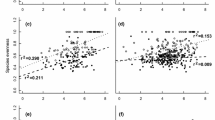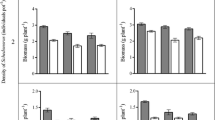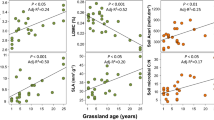Abstract
Litter may indirectly affect competitive interactions. It is not clear whether these changes are additive or non-additive indirect effects. Non-additivity could result from: (1) changes in biomass allocation patterns by competitors towards organs not directly involved in resource acquisition (e.g., longer hypocotyls); (2) changes in the proportion of different functional groups (e.g., grasses and forbs) that possess different competitive abilities; or (3) through priority effects caused by subtle changes in timing of emergence. We used a combination of field and glasshouse experiments in which Eucalyptus obliqua seedlings were grown either with or without leaf litter (grass litter/eucalypt litter), and with or without competitors. Eucalypt species growing in the field and in pots attained more biomass with litter than without when competitors were absent. Competition substantially decreased the biomass of eucalypt seedlings. Competitive intensity was heavily influenced by litter type and was most intense in the presence of grass litter. Litter produced a small change in patterns of biomass allocation in the competing herbaceous vegetation, and there was a slight (marginally non-significant) indication of a change in the proportion of grasses relative to forbs when litter was present. However, when the integral of competitor biomass over time was used to calculate competitive intensity, the combined effects of the experimental factors (litter and competition) became additive, suggesting that the effect of leaf litter on the timing of germination and establishment in the grasses and forbs, relative to that of Eucalyptus seedlings, was the principal mechanism by which leaf litter altered the interaction strength of the species studied.





Similar content being viewed by others
References
Bergelson J (1990) Life after death: site pre-emption by the remains of Poa annua. Ecology 71:2157–2165
Bonser SP, Reader RJ (1995) Plant competition and herbivory in relation to vegetation biomass. Ecology 76:2176–2183
Bruno JF, Stachowicz JJ, Bertness MD (2003) Inclusion of facilitation into ecological theory. Trends Ecol Evol 18:119–125
Callaway RM, Pennings SC, Richard SC (2003) Phenotypic plasticity and interactions among plants. Ecology 84:1115–1128
Castro J (2006) Short delay in timing of emergence determines establishment success in Pinus sylvestris across microhabitats. Ann Bot 98:1233–1240
Catovsky S, Bazzaz FA (2000) The role of resource interactions and seedling regeneration in maintaining a positive feedback in hemlock stands. J Ecol 88:100–112
Cebrián J, Duarte CM (1994) The dependence of herbivory on growth rate in natural plant communities. Funct Ecol 8:518–525
Collins SL, Good RE (1987) The seedling regeneration niche: habitat structure of tree seedlings in an oak-pine forest. Oikos 48:89–98
DeStevens D (1991) Experiments on mechanisms of tree establishment in old-field succession: seedling emergence. Ecology 72:1066–1075
Eckstein RL, Donath TW (2005) Interactions between litter and water availability affect seedling emergence in four familial pairs of floodplain species. J Ecol 93:807–816
Facelli JM (1994) Multiple indirect effects of plant litter affect the establishment of woodyseedlings in oldfields. Ecology 75:1727–1735
Facelli JM, Facelli E (1993) Interactions after death: plant litter controls priority effects in a successional plant community. Oecologia 95:277–282
Facelli JM, Kerrigan R (1996) Effects of ash and four types of litter on the establishment of Eucalyptus obliqua. Ecoscience 3:319–324
Facelli JM, Ladd B (1996) Germination requirements and responses to leaf litter of four species of eucalypt. Oecologia 107:441–445
Facelli JM, Pickett STA (1991a) Plant litter: its dynamics and effects on plant community structure. Bot Rev 57:1–32
Facelli JM, Pickett STA (1991b) Plant litter: light interception and effects on an oldfield plant community. Ecology 57:1024–1030
Facelli JM, Williams R, Fricker S, Ladd B (1999) Establishment and growth of seedlings of Eucalyptus obliqua: interactive effects of litter water and pathogens. Aust J Ecol 24:484–494
Foster BL (1999) Establishment competition and the distribution of native grasses among Michigan old-fields. J Ecol 87:476–489
Goldberg DE, Landa KL (1991) Competitive effect and response: hierarchies and correlated traits in the early stages of competition. J Ecol 79:1013–1030
Goldberg DE, Novoplansky A (1997) On the relative importance of competition in unproductive environments. J Ecol 85:409–418
Grime JP (2007) Plant strategy theories: a comment on Craine (2005). J Ecol 95:227–230
Groner E, Ayal Y (2001) The interaction between bird predation and plant cover in determining habitat occupancy of darkling beetles. Oikos 93:22–31
Haag JA, Coupe MD, Cahill JF Jr (2004) Antagonistic interactions between competition and insect herbivory on plant growth. J Ecol 92:156–167
Hutson BR (1985) Rates of litter fall and organic matter turnover at three South Australian indigenous forest sites. Aust J Ecol 10:351–359
Keever C (1973) Distribution of major forest species in southeastern Pennsylvania. Ecol Monogr 43:303–327
Langkamp P (1987) Germination of Australian native plant seed. Inkata, Melbourne
Lee KE, Correll RL (1978) Litter fall and its relationship to nutrient cycling in a South Australian dry sclerophyll forest. Aust J Ecol 3:243–252
Miller TE (1987) Effects of emergence time on survival and growth in an early old-field plant community. Oecologia 72:272–278
Molofsky J, Lanza J, Crone EE (2000) Plant litter feedback and population dynamics in an annual plant Cardamine pensylvanica. Oecologia 124:522–528
Morin PJ, Lawler SP, Johnson EA (1988) Competition between aquatic insects and vertebrates: interaction strength and higher order interactions. Ecology 69:1401–1409
Motulsky H (1995) Intuitive biostatistics. Oxford University Press, New York
Oksanen L, Sammul M, Mägi M (2006) On the indices of plant–plant competition and their pitfalls. Oikos 112:149–155
Patten BC (1991) Network ecology: indirect determination of the life-environment relationship in ecosystems. In: Higashi M, Burns TP (eds) Theoretical studies of ecosystems: the network perspective. Cambridge University Press, Cambridge, pp 288–351
Peterson CJ, Facelli JM (1992) Contrasting germination and seedling growth of Betula alleghaniensis and Rhus typhina subjected to various amounts and types of plant litter. Am J Bot 79:1209–1216
Poorter H, De Jong R (1999) A comparison of specific leaf area, chemical composition and leaf construction costs of field plants from 15 habitats differing in productivity. New Phytol 143:163–176
Quinn JM, Smith BJ, Burrell GP, Parkyn SM (2000) Leaf litter characteristics affect colonisation by stream invertebrates and growth of Olinga feredayi Trichoptera: Conoesucidae. NZ J Mar Freshwater Res 34:273–287
Riginos C, Milton SJ, Wiegand T (2005) Context-dependant interactions between adult shrubs and seedlings in a semi-arid shrubland. J Veg Sci 16:331–340
Rotundo JL, Aguiar MR (2005) Litter effects on plant regeneration in arid lands: a complex balance between seed retention seed longevity and soil–seed contact. J Ecol 93:829–838
SAS Institute (1986) Statistics user’s guide. SAS Institute, USA
Shea K, Kelly D, Sheppard AW, Woodburn TL (2005) Context-dependent biological control of an invasive thistle. Ecology 86:3174–3181
Shipley B (2006) Net assimilation rate specific leaf area and leaf mass ratio: which is most closely correlated with relative growth rate? A meta-analysis. Funct Ecol 20:565–574
Shurin JB, Amarasekare P, Chase JM, Holt RD, Hoopes M, Liebold MA (2003) Alternative stable states and regional community structure. J Theor Biol 227:359–368
Stanton ML (1985) Seed size and emergence time within a stand of wild radish Raphanus raphanistrum L.: the establishment of a fitness hierarchy. Oecologia 67:524–531
Stinchcombe JR, Schmitt J (2006) Ecosystems engineers as selective agents: the effects of leaf litter on emergence time and early growth in Impatiens capensis. Ecol Lett 9:258–270
Tilman D (2007) Resource competition and plant traits: a response to Craine et al. 2005. J Ecol 95:231–234
Twidale CR, Tyler MJ, Webb BP (1976) Natural history of the Adelaide region. Royal Society of South Australia, South Australia
Violle C, Richarte J, Navas M (2006) Effects of litter and standing biomass on growth and reproduction of two annual species in a Mediterranean old-field. J Ecol 94:196–205
Werner EE (1992) Individual behaviour and higher-order species interactions. Am Nat 140:5–32
Werner EE, Peacor SD (2003) A review of trait mediated indirect interactions in ecological communities. Ecology 84:1083–1100
Wissinger S, McGrady J (1993) Intraguild predation and competition between larval dragonflies: direct and indirect effects on shared prey. Ecology 74:207–218
Wootton TJ (1993) Indirect effects and habitat use in an intertidal community: interaction chains and interaction modifications. Am Nat 141:71–89
Xiong S, Nilsson C (1999) The effects of plant litter on vegetation: a meta-analysis. J Ecol 87:984–994
Xiong S, Johansson ME, Hughes FMR, Hayes A, Richards KS, Nilsson C (2003) Interactive effects of soil moisture vegetation canopy plant litter and seed addition on plant diversity in a wetland community. J Ecol 91:976–986
Acknowledgements
Thanks to George Ganf, Andrew Smith, Dudley Pinnock and Wendy Stubbs for critically reading earlier versions of the manuscript. Thanks to Spiros Giannakopoulos and Nigel Randall for help with the glasshouse experiment, and the editorial team and anonymous reviewers at Oecologia for their helpful critiques that improved the manuscript. The experiments performed as part of this study are compliant with Australian law.
Author information
Authors and Affiliations
Corresponding author
Additional information
Communicated by Scott Collins.
Rights and permissions
About this article
Cite this article
Ladd, B., Facelli, J.M. Priority effects produced by plant litter result in non-additive competitive effects. Oecologia 157, 687–696 (2008). https://doi.org/10.1007/s00442-008-1110-2
Received:
Accepted:
Published:
Issue Date:
DOI: https://doi.org/10.1007/s00442-008-1110-2




